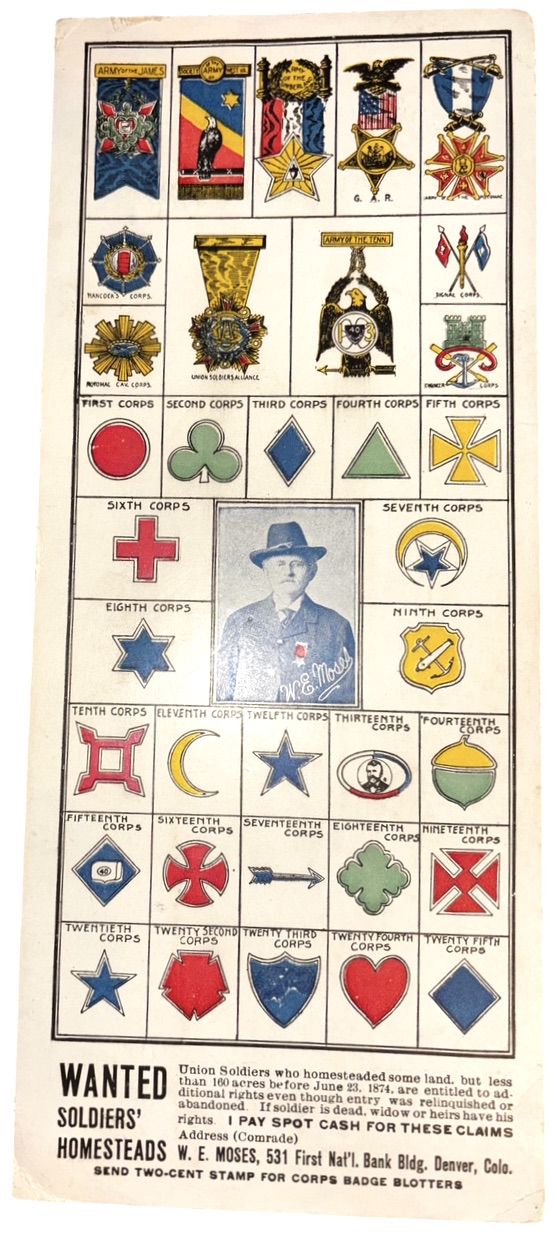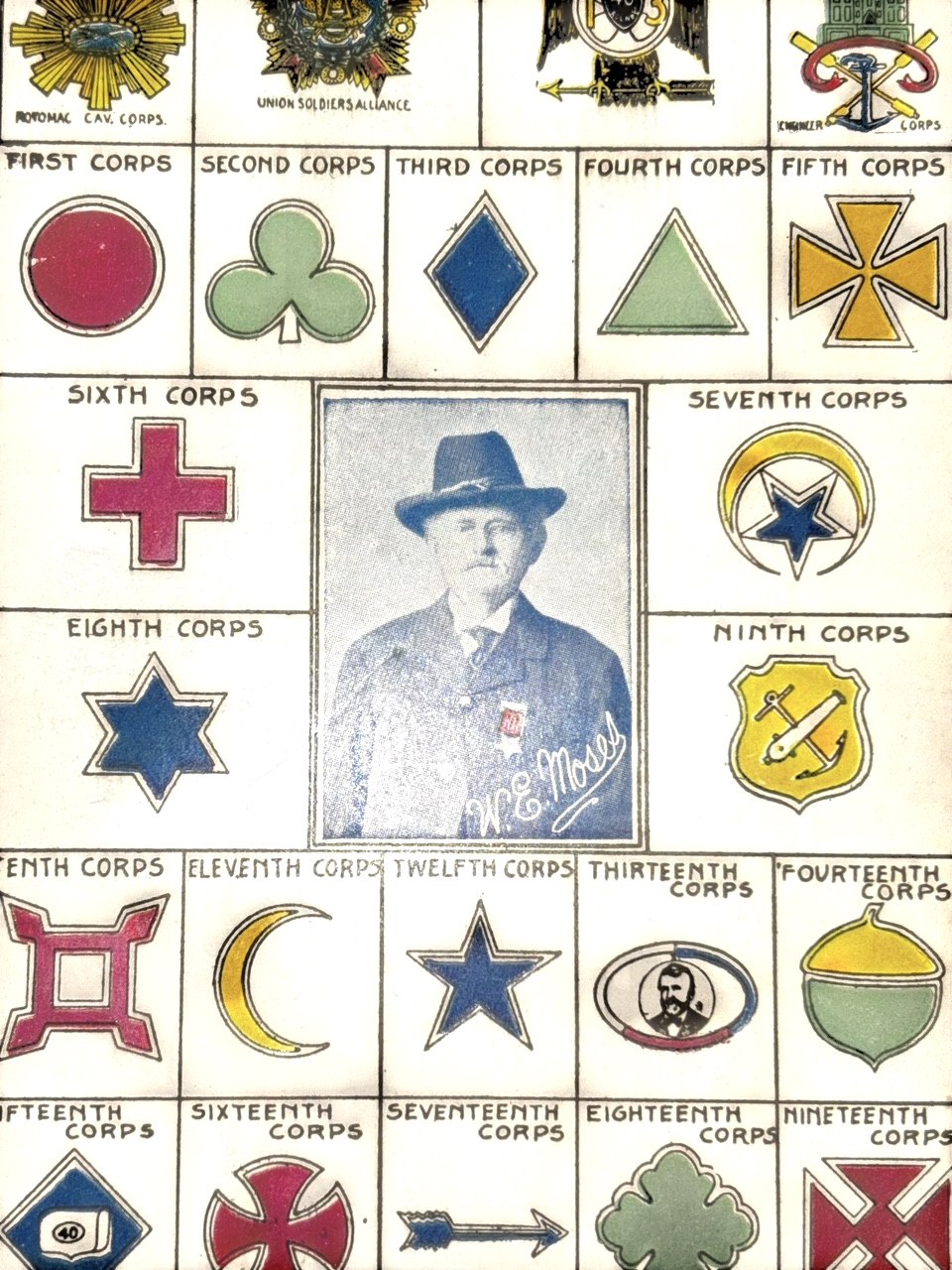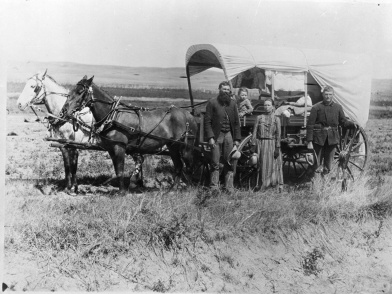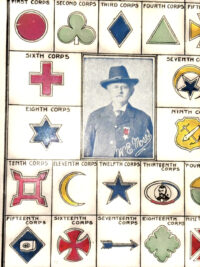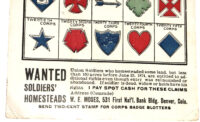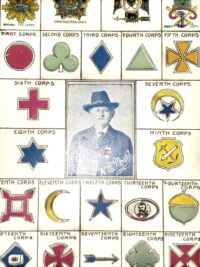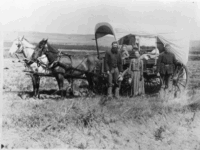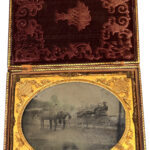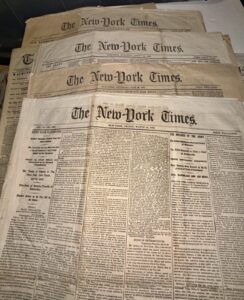Early 1870s Unusual Ad in the Form of a Decorative Blotter for Purchasing Ex-Civil War Union Soldier’s Homestead Grants – Offered by a Former Officer in the USCT Heavy Artillery
$175
Early 1870s Unusual Ad in the Form of a Decorative Blotter for Purchasing Ex-Civil War Union Soldier’s Homestead Grants – Offered by a Former Officer in the USCT Heavy Artillery – This unique “blotter ad” is unlike anything comparable that we have encountered before. With the termination of hostilities, many Union veterans, black and white, would claim homestead lands under the Homestead Act of 1862; principally offered for land in the West by the Federal Government in compensation for their service, many ex-soldiers took advantage of these offers. This ad, apparently printed by an ex-Army Officer and USCT Commander, William E. Moses, offers veterans who were entitled to receive land grants, to buy their claims, with “SPOT CASH” (assumably on the spot); he also offers to send copies of the blotter if someone sends him a “TWO-CENT STAMP”. The ad is in the form of an ink blotter, which has seen some modest use; on the decorative side of the ad, are brightly colored depictions of the various Union Corps designations and Army Medals. Additionally, an image of Lt. Moses, attired in a GAR coat and hat, wearing a GAR medal, appears in the middle of the ad. The ad remains in excellent condition.
From the beginning, the Homestead Act of 1862 gave special privileges to veterans—allowing soldiers to claim homesteads even if they did not meet the homesteading requirement of being 21 years of age or older. The granting of veterans’ benefits under the Homestead Act of 1862 was used to replace the older system by which veterans were granted land via documents called “military bounty land warrants.” These transferrable documents had often been sold to non-veterans for quick cash.
Measurements: L – 9.5”; W – 4.5″
William E. Moses
Residence McKean County, PA.
Enlisted on 10/11/1861 as a Corpl.
On 10/11/1861, he mustered into “H” Co. Pennsylvania 58th Infantry.
He was discharged for promotion on 3/29/1864 at Morehead City, NC
On 3/29/1864, he was commissioned into “C” Co. US Colored Troops 14th Heavy Artillery.
He resigned on 4/4/1865
(Estimated date of enlistment)
Promotions:
- Sergt 5/3/1863
- 1st Sergt 9/7/1863
- 2nd Lieut 4/29/1864
William E. Moses in the 14th US Colored Heavy Artillery
- Unit: 14th US Colored Heavy Artillery, Company H.
- Enlisted: October 11, 1861, for a three-year term.
- Born: Cuba, NY.
- Age at enlistment: 22.
- Physical characteristics: 5’10” tall, light complexion, blue eyes, and auburn hair.
- Occupation: Farmer.
58TH PA Infantry
PENNSYLVANIA 58TH INFANTRY (Three Years) Fifty-eighth Infantry.-Cols., J. Richter Jones, Carlton B. Curtis Cecil Clay Lieut.-Cols., Carlton B. Curtis, Montgomery Martin, Charles A. Winn, Cecil Clay, Robert C. Redmond; Majs., Montgomery Martin, Henry Metcalf, Charles A. Winn, Cecil Clay, Robert C. Redmond, Joseph E. Johnson. The 58th regiment was organized at Philadelphia from Sept. 21, 1861, to March 1, 1862. Companies A, B, C, D and K were recruited from Philadelphia and vicinity by J. Richter Jones and consolidated with companies E, F, G, H and I recruited in Warren, McKean, Cameron Clinton, Northumberland, Luzerne and Potter counties by Carlton B. Curtis. Each had been authorized by the governor to raise a regiment and they combined their forces to form the 58th, which left the state for Fortress Monroe in two detachments on March 8, 1862, arriving on the day of the contest between the Merrimac and Monitor and going into camp at Camp Hamilton. On May 1O, the regiment embarked for an expedition to Norfolk, under command of Gen. Wool, and after performing provost guard duty in Norfolk for a few days moved to Portsmouth, where it remained on guard duty until Oct. 11. Ordered then to Suffolk it encamped there until Jan. 1863, sharing meanwhile in two expeditions to the Blackwater river. On Jan. 5, 1863, it moved with the force under Gen. Foster to Beaufort, N. C., and went into camp at Batchelder’s Creek Station, 8 miles west of New Berne. On Feb. 12, it surprised a Confederate camp at Sandy ridge, capturing 143 prisoners. It was engaged with the enemy on the Neuse road in April, at Cone creek on the Dover road a few days later, and took part in the Dover road action on April 28. In the action at Gum swamp in May it shared in the capture of the enemy’s works, 125 prisoners, 1 gun, many small arms, and valuable stores being taken. In a skirmish at Batchelder’s creek the following day, Col. Jones was killed and was succeeded by Lieut.-Col. Curtis. Said Gen. Foster: “Col. Jones won the admiration of all in this department by the indefatigable, able and gallant manner with which he filled the arduous duties of commander of the outposts. On May 24, the 58th moved to New Berne and on June 27 to Washington, N. C., where it remained on garrison and provost duty until the evacuation of the place in April, 1864, sharing meanwhile in a number of expeditions into the interior. On May 1, it joined Gen. Butler’s army, then being organized at Yorktown to operate against Richmond. It was assigned to the 3rd brigade, 1st division, 18th corps, and participated in the campaign south of the James, being sharply engaged with the enemy on the 9th, with a loss of 20 killed and wounded and aiding in the destruction of the Petersburg & Richmond railroad. With its corps it joined Grant’s army at Cold Harbor and in the action there suffered a loss of 35 killed and wounded. It was again heavily engaged on the 3rd in the grand assault and suffered considerable loss. Remaining at the front until June 13, it returned by transport to Bermuda Hundred, crossed the Appomattox and shared in the first assaults in front of Petersburg. It was then relieved and returned to Point of Rocks. The reenlisted men had never received their veteran furlough and on June 24 went to Pennsylvania to enjoy their long delayed respite, being given 20 days additional. The recruits and members who had not reenlisted, remained on picket and fatigue duty, under command of Capts. Leiper and Jackson, until the veterans, together with new recruits, returned to the front on Aug. 25. With the 188th Pa., it was selected to lead the desperate assault on Fort Harrison, where in the fierce onset, the regimental colors repeatedly fell, but were finally planted upon the parapet by Capt. Cecil Clay. Its loss here was 6 officers and 128 men out of 9 officers and 228 men engaged. On the afternoon of the same day, with the 188th Pa., it attacked the “Star Fort,” scaled the ramparts and spiked the guns, but was forced to retire, its supports failing it. It was now employed in guard, picket and fatigue duty shared without loss in the action at Fair Oaks in October and at Spring Hill in December, bore an honorable part in the final campaign which resulted in the evacuation of Petersburg and Richmond and the surrender of Lee; and on the close of hostilities served by detachments in southern Virginia until the end of 1865. It was mustered out at City Point, Va., Jan. 24, 1866.
UNITED STATES COLORED TROOPS. 14th REGIMENT HEAVY ARTILLERY. Organized at New Berne and Morehead City, N. C., from 1st North Carolina Colored Heavy Artillery March 17, 1864. Attached to Defenses of New Berne, N. C., Dept. of Virginia and North Carolina, to January, 1865. Sub-District of New Berne, Dept. of North Carolina, and Sub-District of Beaufort, N. C., Dept. of North Carolina, to December, 1865. SERVICE.—Garrison duty at New Berne and other points in the Dept. of North Carolina till December, 1865. Mustered out December 11, 1865.
An advertisement for Civil War homesteaders would have used the 1862 Homestead Act to promote 160 acres of free government land to any citizen who could “never borne arms against the U.S.”. The ad would have highlighted benefits like land ownership after five years of continuous residence, home building, and land cultivation for a small filing fee, or the option to purchase land after six months for $1.25 per acre. It would have been a way to encourage settlement in the western United States, especially for veterans seeking a new start, notes HistoryNet.
Ad content and target audience
- Headline: “FREE LAND! For U.S. Citizens in the West!” or “Civil War Veterans: Your Chance for a New Beginning!”
- Target audience: Veterans of the Union Army, but also any US citizen or intended citizen, including women and immigrants, who met the age and loyalty requirements.
- Key Selling Points:
- Free land: Get a 160-acre farm for free.
- Opportunity: Start a new life on the frontier, build a home, and become a landowner.
- Special benefits for veterans: Union soldiers could have time served in the war counted towards the five-year residency requirement.
- Clear path to ownership: A straightforward process of filing a claim, living on and improving the land, and then receiving a deed.
- Call to action: “Visit your local land office today to claim your 160 acres!”
- Important caveats to include:
- Must be the head of a household or 21 years old.
- Must never have borne arms against the United States.
- Must live on and “improve” the land for five years (build a house, cultivate crops, etc.).
- The land was not always the best quality, and many homesteaders failed to make it work.
Example Advertisement
“Attention Civil War Veterans & Citizens!”
FREE LAND AVAILABLE IN THE WEST!
The U.S. Government is offering 160 acres of land to every citizen who has never borne arms against the Union. Take this unprecedented opportunity to own your own farm and build a new life on the American frontier.
For veterans: Your time in service counts toward the five-year residency requirement!
Requirements:
- Be a U.S. citizen (or intend to become one)
- Be the head of a household or at least 21 years old
- Build a home on the land
- Cultivate the land
How it works:
- File a claim at your local land office.
- Live on and improve your land for five years.
- Pay a small fee to receive your deed of title.
Don’t miss this chance to claim your future!
Visit your nearest Land Office to learn more.

